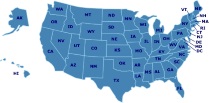Chemistry
From equipment to textbooks, websites to periodic tables, you'll find everything you need to successfully teach chemistry in your homeschool.
Things to See & Do in Missouri
Discovery Center of Springfield
The Discovery Center of Springfield is an interactive, hands-on museum committed to inspiring people of all ages with a life-long love of learning and an appreciation of the world and our place in it. Exhibits and programs explore the hard sciences, technology, math, health, the environment, culture, art, and communications.
Chemistry Teaching Tips & Ideas
Chem4Kids
A great website for kids to learn about chemistry. Basic chemistry help and information with facts about matter, atoms, elements, the periodic table, reactions and biochemistry.
How I Teach a Large Family in a Relaxed, Classical Way: Science
Family style learning is a great way to tackle lots of different subjects, including science.
Chemistry Homeschool Curriculum
Christian Kids Explore Chemistry
These user-friendly, unabashedly Christian, one-year science curriculums for elementary students include teaching lessons, coloring pages, hands-on time, memorization lists, review sheets, creative writing assignments, and a supplemental book list. The Chemistry text is intended for grades 4-8, and includes such hands-on activities as making model atoms, breaking covalent bonds, and making gas expand. It also lists chemistry terms, notations, and rules. The conversational style gives students the basic information they need, making this an ideal first course in life science, especially useful for those following a classical approach.
Chemistry Activities & Experiments
ExploraVision
ExploraVision is a competition for all students in grades K-12 attending a school in the U.S., Canada, U.S. Territory or a Department of Defense school. Homeschooled students are eligible to enter. It is designed to encourage students to combine their imagination with their knowledge of science and technology to explore visions of the future. Teams of students select a technology, research how it works and why it was invented, and then project how that technology may change in the future. They must then identify what breakthroughs are required for their vision to become a reality and describe the positive and negative consequences of their technology on society. Winning ideas have focused on things as simple as ballpoint pens and as complex as satellite communications. The student teams write a paper and draw a series of Web page graphics to describe their idea. Regional winners make a Web site and a prototype of their future vision.
Featured Resources
As an Amazon Associate, we earn from qualifying purchases. We get commissions for purchases made through links on this site.
Guerrilla Learning: How to Give Your Kids a Real Education With or Without School
If you’ve ever felt that your child wasn’t flourishing in school or simply needs something the experts aren’t supplying, you’re ready to become a "guerrilla educator." this books explains what’s wrong (and what’s useful) about our traditional schools and shows you how to take charge of your family’s education to raise thinking, creative young people despite the constraints of traditional schooling. Filled with fun and exciting exercises and projects to do with children of all ages, this rem...
Raising Topsy-Turvy Kids: Successfully Parenting Your Visual-Spatial Child
Understanding how children learn best allows you to meet their needs and help them succeed. A visual-spatial learner remembers things in pictures and learns better with visual clues and strategies. This book addresses those needs and helps you figure out how to encourage this type of learner in your homeschool environment.
Upside-Down Brilliance: The Visual Spatial Learner
Dr. Linda Silverman coined the term "visual-spatial learner" to describe the special and unique gifts of people who learn best through seeing and with images. This guide is a great resource as you support your homeschooling visual learner in discovering the best ways to learn and succeed.
I Learn Better by Teaching Myself/Still Teaching Ourselves
Take a look at how a homeschooling mother learned to trust her children-and herself-to learn in new ways. Tag along on the journey from the elementary years through high school as this book explore the success and freedom of unstructured learning. These books are especially good for anyone wrestling with the question of "how much structure should there be in a homeschool?"
A Reason For® Handwriting
A Reason For® Handwriting provides a fun, meaningful approach to developing effective handwriting skills. Each lesson is built around a Scripture verse chosen not only for proper letter combinations, but also inspirational content. “Border Sheets” encourage students to share God's Word with others. You'll find product information about A Reason For® Handwriting here.




